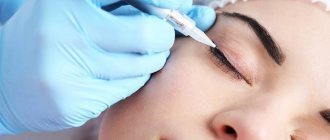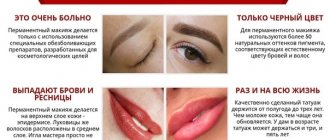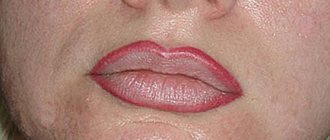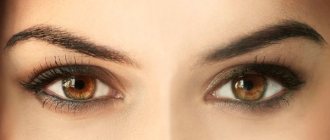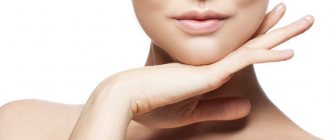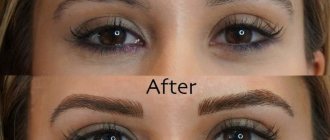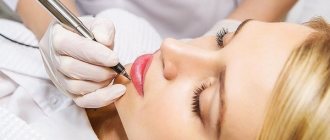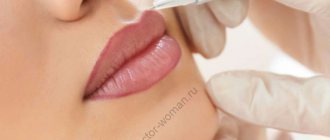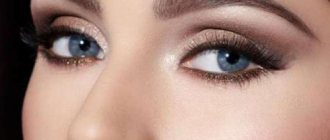Date of publication: 07/20/2017 8104
About 80% of the excellent result of eyelid tattooing is proper eye care after the procedure. Your appearance, healing speed and even the durability of the permanent depend on it.
Skin healing
This area of the face is characterized by swelling. It occurs as a natural reaction to the impact of a needle and the introduction of pigment under the skin. Swelling normally lasts no more than 1 day, then gradually subsides.
Types of eyelid tattooing
There are 3 types of procedures, which are selected by the cosmetologist individually for each patient:
- Interlash application. The space under the skin next to each eyelash of the eyelid is filled. The technique can be performed for both the upper and lower eyelids. The effect after the procedure occurs instantly, the effect lasts for many years. During the procedure, the cosmetologist must take into account the individual parameters of the patient’s eyes. After completing the method and skin care, you can additionally apply makeup, then the effect of lush eyelashes will be created.
- Arrow. In this case, the pigment is also applied to the area under the skin, but is done in the form of a drawn arrow above the eyelashes, which a woman could apply herself. Unlike temporary makeup, such arrows will be long-term; there is no need to apply cosmetics daily.
- Additional shading. The same technique for applying pigment is used, but the effect is created as after shading makeup. After completion of the procedure, the eyes will look impressive and expressive.
The type of tattoo is chosen by the patient herself. It depends on preferences, purposes of use and taste.
How long does eye tattoo last?
The durability of permanent makeup directly depends on the characteristics of the body, age and lifestyle that a woman leads. Most often, the tattoo comes off after 3-4 years, but in some cases it can last for about 10 years. Of course, by the end of the term it will fade, but it will still be noticeable.
The younger the girl, the higher her metabolism and the less the tattoo will last, and vice versa. Frequent visits to baths and saunas also have a negative impact on the time spent wearing permanent makeup, as does peeling.
How to make a tattoo
The eyelid tattooing procedure is carried out in several stages:
- cleansing the skin surface in the place where the pigment will be applied under the skin;
- prescribing an anesthetic, which is used only locally to numb the area where the pigment is applied (this should be done carefully, since contact with the mucous membrane of the eyes causes side effects);
- the procedure itself is performed, during which the cosmetologist uses a small needle to apply pigment under the skin of the eyelids (it must be stretched so that the substance gets into all the folds and no empty sections are formed);
- reapplying the anesthetic so that the patient does not feel pain immediately after the procedure is completed;
- application of a drug that promotes increased regeneration, for example, Solcoseryl (eyelids heal faster).
After the procedure, you need to find out from the cosmetologist how to go through the healing period so that inflammation or bacterial infection does not form.
When should you take Dexamethasone or Prednisolone?
If the swelling persists for more than 3 days, subject to following the recommendations for care and taking medications, you should consult a doctor.
The powerful synthetic drug Dexamethasone, which is a glucocorticoid compound that regulates mineral, carbohydrate and protein balance in the body, promises emergency assistance.
This drug is actively used in ophthalmic practice. The duration of use of the drug will depend on the clinical picture, from 3 to 30 days.
Prednisolone promises a similar effect. It is an antiallergic, immunosuppressive and anti-inflammatory drug used in ophthalmology (0.5% eye drops). Prednisolone instillations are carried out 2 drops 3 r. per day.
In the case of the acute phase of eye disease, it is permissible to increase the frequency of administration (every 2-4 hours).
Rules of care after eyelid tattooing
After the procedure, it is necessary to follow a number of important rules that prevent complications and promote rapid tissue restoration:
- on the first day after the procedure, you should not wash your face, even with plain water;
- on the second and subsequent days, you can use cool water to wash your face; it is not recommended to use chemicals;
- after washing, you should not wipe your eyes with a towel to prevent the removal of pigment; they must dry on their own;
- With the permission of a doctor or cosmetologist, apply a moisturizer specifically designed for post-tattoo care.
Ointment for tissue healing is applied every few hours in the first days after the procedure. Gradually this time is reduced. After one week, you can use the ointment 2 times a day. This is done in order to prevent dry eyes, which can cause crusts and cracking of the skin.
Care for arrows or shading
Swelling often occurs in the area of the arrows, but not for long. In addition to the cold compress, you can take a diuretic for 5-7 days. Optimally – “Veroshpiron” (1 capsule 50 mg in the morning), “Hypothiazide” (12.5-25 mg in the morning). Furosemide should not be used because it is too strong.
Important! Diuretics disrupt the balance of potassium and magnesium. Together with them you need to take Asparkam (2 tablets 3 times a day) or Panangin (1-2 tablets 3 times a day).
If an allergic reaction occurs, which is not uncommon in the area of arrows, you should take an antihistamine. Zodak does not cause drowsiness.
The specialist will recommend you a medicinal ointment for the eyelids. Please check the mode of use as it differs from the standard one.
After the procedure, be sure to instill eye drops against redness and infection. These can be “Albucid”, “Vizin”, etc. During the healing period, glasses are used instead of lenses.
Pharmacy drugs
To prevent complications after the procedure, it is recommended to use the following medications:
- Etonium is an antiseptic that helps eliminate bacteria in the area of application, acts gently and does not dry out the skin;
- ointment based on hydrocortisone - contains an anti-inflammatory hormonal agent, the drug is applied topically, it helps eliminate the inflammatory effect and moisturize the skin (due to the presence of excipients);
- Tetracycline ointment is a broad-spectrum antibiotic intended to prevent the development of infection and its spread into deep tissues after the procedure.
All medications must be applied in strict dosages. Some of them may cause side effects if used incorrectly. Since the drugs are used only locally, systemic adverse reactions are rare.
Diuretic medications
Diuretics help get rid of excess fluid in the body. By taking a tablet of Veroshpiron, Furosemide, Trifas, you can achieve the desired result.
On the eve of a beauty session, you should exclude black tea, alcohol, coffee and other drinks that can increase blood pressure from your diet. Also prohibited are salty, spicy and other foods that will force you to drink excessively.
It is important to know! Diuretics such as Furasemide can be used occasionally, as they are very effective drugs and can cause mineral deficiency in the body.
What absolutely should not be done
There are prohibitions that cannot be carried out immediately after tattooing:
- on the first day after the procedure, you should not swim or wet your eyes;
- While the tissue is healing, you should not apply cosmetics, as it can spread into the damaged skin of the eyelids, causing bacterial infection;
- minimize physical activity and sports while the damaged tissues are being restored;
- You should not visit the bathhouse, sauna, or sunbathe under the bright sun, as this can cause bleeding and inflammation of the affected area;
- Do not apply alcohol-based products, as this will cause skin irritation;
- It is forbidden to touch your eyelids without first disinfecting your hands.
The first time after the procedure, the patient will experience discomfort in the eyelid area, itching, burning, and pain. The skin may peel or crack. These are not scary phenomena. Symptoms can be corrected with the help of painkillers and moisturizing ointments.
Using dry ice
Swelling and slight redness after the procedure of applying permanent eyelid makeup is a normal reaction of the body. With the necessary care, this unpleasant symptom will pass.
You can get rid of the appearance of tear-stained eyes on the second day by using cooling compresses and applying dry ice . Low temperatures force blood vessels to constrict, thereby reducing swelling.
Popular site article: How to care for and what to lubricate eyebrows after microblading
Rescue crystals must be placed in a cloth and applied to the inflamed eyelids for 10-15 minutes. In this case, it is important not to overdo it, so as not to provoke the formation of barley.
Note! Proper care ensures the disappearance of puffiness and swelling of the eyelids on the second day after the permanent eyelid makeup procedure.
Answers to frequently asked questions
When can you wash your face after eyelid tattooing?
You should not wash your face only on the first day after the procedure. If no adverse reactions occur, washing with water is allowed from day 2.
Do I need to use antibiotics to prevent an infection?
Antibacterial agents are required to be used. Systemic drugs in the form of tablets and suspensions are not used. Only topical antibiotics are used in the form of an ointment. For example, Erythromycin or Tetracycline ointment.
How to choose the type of tattoo?
The choice of variety depends on the taste preferences of the patient. You can consult with a cosmetologist who will suggest the most optimal option.
Do I need to take hydrocortisone-based medications to prevent pigment rejection?
No, you shouldn't do this. Such use of the drug will affect the entire body as a whole, which will lead to the formation of adverse reactions. Only topical hydrocortisone ointment is used and applied only to the eyelids.
What to do if your eyes are very sore or festered?
In this case, you must immediately apply an antibacterial agent and immediately consult an ophthalmologist. Getting bacteria under the skin can cause inflammation to spread throughout the eyelids. Drug therapy is carried out immediately after visiting a doctor.
All about permanent makeup, tattooing
For a woman, makeup has always been a kind of protection that has to be removed from time to time. Most of us are terrified of being caught off guard without makeup. However, the beauty industry has made sure that from now on ladies will never get into trouble.
Permanent makeup and tattooing are the result of introducing a coloring pigment into the skin using special equipment.
Where is it popular to do it today? The leaders in this regard are eyebrows, eyes and lips, but many ladies are not averse to adding a permanent fly above their lip.
As it turns out, the world of makeup experiences changes in fashion trends from time to time. Not so long ago there was a boom in eye tattooing, but now eyebrows have become the leaders; by analogy, we can assume that we should soon expect a “lip” time.
Indications for permanent makeup
When, or more precisely, in what cases do women decide to have permanent makeup?
There can be many reasons to get a permanent one. The most basic one is laziness, because every morning repeating the same manipulations with pencil and lipstick is quite tiring, so the prospect of immediately waking up fully armed is very tempting.
Another reason to do permanent makeup is age. High-quality permanent makeup can make a woman look younger by several years. There is a reason for this: with age, eyebrows thin and lighten, lips turn pale, and permanent, natural, discreet colors can easily distract attention from wrinkles.
Those ladies whose faces lack symmetry also resort to this magical method. The permanent can correct the shape of the eyebrows, the size and asymmetry of the eyes.
Often it is simply necessary for people who have undergone plastic surgery or other types of surgical intervention.
Many women turn to permanent makeup due to specific working conditions that exclude the possibility of using conventional makeup. Especially when the profession involves regular contact with water: in saunas, swimming pools, water parks.
What is the difference between permanent makeup and tattooing?
Permanent makeup is the same thing as a tattoo. It lasts almost a lifetime, and can only be removed with a laser. But what suits a young girl’s face is hardly suitable for a lady over forty and certainly not at all appropriate for a woman over sixty. And fashion changes quickly. Therefore, in our Center, specialists prefer to perform permanent makeup rather than tattooing. This is micropigmentation of the surface layer of the skin, which is gradually “washed off” over 1.5 - 4 years. Permanent makeup done in this way will look very natural and natural and can completely replace daily makeup.
How is permanent makeup done?
The process of applying permanent makeup begins with a kind of marking.
The cosmetologist draws the desired result on your face, so that he has something to strive for and what to expect.
Next you need to decide on the pigment. The main problem is that you can never be completely sure what shade you will get on your skin. There are so many individual skin characteristics that the same pigment can look completely different on different girls.
You can hear many “horrors” and legends about the permanent makeup procedure itself. Ladies love to scare each other with the fact that permanent makeup is a rather sensitive process. However, rumors about his pain are greatly exaggerated. It is least pleasant to do permanent lip makeup, which is why cosmetologists resort to freezing and anesthetizing this area. The higher you tattoo, the less noticeable the cosmetologist’s manipulations will be.
So, permanent eye makeup is a process that is more nerve-wracking than painful. This is due to the fact that the client always has some concern: will the master accidentally miss the century. With such thoughts, you need to completely trust the cosmetologist and overcome your fears.
Permanent eyebrow makeup is the least painful procedure, but you can’t vouch for all people here, because a lot is decided by the individual pain threshold.
Duration of permanent makeup application
The procedure time largely depends on the professional skills of the specialist.
Some manage to do everything quickly and efficiently in about one and a half to two hours, while others need a fair amount of time to achieve the same result.
Permanent makeup correction
Within 1.5 - 2 months after the initial procedure, you must come for correction (of course, if you care about your face). It will increase the pigment density, because... a true professional will never perform the procedure in full at the initial appointment. The specialist will apply the pigment very easily in order to evaluate after healing how the pigment behaves in your skin and if the result suits both you and the specialist, the pigment will be applied to the required intensity.
The “life” of permanent makeup varies: depending on your individual characteristics, it can last from one to four years and will depend on:
- Depending on your skin type. Oily skin removes pigment faster, dry skin retains it longer.
- From the color of the pigment. Bright shades last longer than their pale counterparts.
- From age. The older you get, the longer the skin retains its pigment.
- From immunity. The better your immune system works, the faster your body “removes” the pigment as a foreign substance, despite the fact that the pigment consists of minerals.
- From exposure to UV rays. The sun and solarium destroy the pigment, because... tanning protects the skin from burns and skin cells begin to renew faster, and therefore the pigment brightens. Therefore, when you sunbathe, you need to apply a cream with a high protection factor to the permanent area.
On average, it is necessary to maintain the quality of a tattoo once every 1-1.5 years in order to refresh, renew the color, shape and look neat.
What should you pay attention to when planning to do this procedure?
- Firstly, safety. Therefore, it is very important to apply permanent makeup (tattoo) in a medical center. Our Center does not skimp on the safety of our patients and does not risk its reputation. The center’s specialists are true professionals in their field with extensive experience. The procedure is performed using the most modern and sophisticated techniques. The work uses modern equipment, which allows the procedure to be carried out as painlessly as possible. All consumables are sterile and disposable. Needles are opened strictly in front of the patient!
- Secondly, you need to make sure the quality of the pigment. We use only safe, hypoallergenic pigments made in Germany, Switzerland, and Italy. All pigments used are certified.
- And most importantly, you must be sure that even if you have some unpredictable individual reaction, we will help you quickly deal with it, and will not leave you alone with the problem.
What to expect after the procedure?
After the permanent makeup procedure, redness or, conversely, discoloration of the skin at the site of work is observed. As a rule, swelling occurs (lasts up to a day and a half), as a consequence of the body’s natural reaction to injury and anesthetic.
Hematomas, hyperemia, and peeling may also occur. All these manifestations gradually disappear during the healing process of the permanent area. In case of severe swelling, you can take antihistamines after consulting your doctor.
Within 2-5 hours after the procedure, the color evens out and gradually becomes richer and darker, because the pigment lying on the surface and particles of the epidermis undergo an oxidation process in the air, and skin secretions “seal” it. The color will remain this way for 3-10 days: dark, dense and bright. This stage is very important; it is during these days that your future permanent is formed under a bright film. Even if you are confused by the brightness of the color, or its shade is different from the one originally chosen, you need to be as careful as possible with the pigmented area. Then, on days 4-12, this top dark layer of pigment and epidermal particles begins to peel off. After the already familiar, bright and dark color, the exfoliated area of skin looks colorless, because... The epidermis is almost not transparent when restored. Depending on the individual characteristics of the skin, the period of invisibility of the pigment can range from several days to 3 weeks. When the skin regeneration process is completed, the pigment becomes clearly visible again. The achieved result should be judged only after 1 month.
Remember! The degree of preservation of the color and shade of your permanent largely depends on you! Depending on the individual characteristics of your body, immunity, lifestyle, etc.
How to properly care?
- Wipe the permanent area with a cotton pad soaked in chlorhexedine for the 1st day, 2-3 times a day. The remaining days of the healing process (3 days) only once a day.
- Apply a thin layer of dermatoprotective agents to the permanent area. You cannot make greasy compresses or apply more Vaseline - this gives the so-called greenhouse effect and the top layer of the epidermis along with the pigment will peel off.
- Specifically, removing the crust is strictly prohibited, since at the site of removal of this crust, there will be a gap in the color of the pigment and a scar may remain on the skin.
- It is also prohibited:
- wet the permanent area for 4-5 days;
- during healing, use hydrogen peroxide, oils and alcohol tinctures;
- use scrubs, peelings;
- within 20 days after the procedure, use decorative cosmetics;
- take hot baths, visit a bathhouse, sauna, swim in ponds and pools - steam, soak the permanent area;
- visit gyms;
- injure, press, scratch, itch the permanent area;
- It should be remembered that ultraviolet radiation significantly reduces the durability of the pigment, so it is imperative to use sunscreen cosmetics with the maximum degree of protection.
Additional lip care tips
- After tattooing on the lip area, be careful with facial expressions, brushing your teeth, eating, and drinking hot drinks.
- Mandatory recommendations for lip care include taking antiviral medications (as recommended by a doctor). Herpes is the most common complication after permanent lip surgery. Herpes appears in people predisposed to it. Typically, herpes occurs as an exacerbation of a viral infection that already exists. Herpes is a viral disease and is practically incurable; once it gets into your body, it can “sleep” for a long time and “wake up” from any provocateur from the outside, which include: reduced immunity, colds, emotional experiences and stress, trauma, as in the case permanent lip makeup. To prevent herpes (3-5 days before and 2-3 days after lip permanent), the recommendation for care after tattooing is the use of antiviral drugs in the form of tablets, after consulting with a doctor. Antiviral ointments, such as these, should not be used, as these ointments contribute to the removal of coloring pigment from the skin and the appearance of empty areas.
- During the first 2-3 days, it is advisable not to drink hot or scalding drinks, exclude spicy foods (with pepper, spices, etc.).
- Avoid contact with mucous membranes of partners and cosmetics.
Contraindications for permanent makeup (tattoo) are:
- poor blood clotting, taking blood-thinning medications;
- diabetes;
- tendency to form keloid scars;
- symptoms of acute respiratory infections, elevated body temperature;
- oncology in the acute stage;
- skin diseases in the acute stage;
- infectious, venereal diseases;
- herpes in active form;
- AIDS, hepatitis;
- tuberculosis;
- meningitis;
- allergy to anesthesia;
- birthmarks in the area of the intended permanent tattoo;
- menstruation during the procedure,
- pregnancy, lactation;
- mental disorders, epilepsy;
- high blood pressure;
- alcohol intoxication, as well as drinking alcohol several days before and after the procedure;
- tendency to inflammatory diseases of the mucous membrane of the eyes when performing permanent (tattooing) eyelids.
